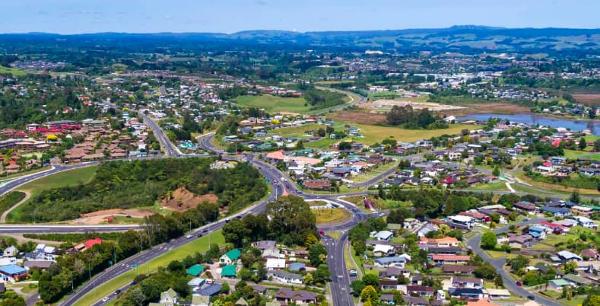Land prices and infrastructure development: Are there ways we can better plan for an uncertain future?

Two new research papers from Te Waihanga, the New Zealand Infrastructure Commission, highlight the link between land prices and infrastructure, and the need to earmark land for future infrastructure.
"Land prices are, in part, an infrastructure issue. On one hand, a shortage of infrastructure can limit development opportunities in cities, contributing to higher prices. On the other hand, high land prices can make it costly and difficult to build infrastructure where and when it is needed," says Geoff Cooper, General Manager - Strategy, Te Waihanga.
Urban land prices and infrastructure
The first report, Urban land prices - a progress report, examines trends in urban land values between 2010/11 and 2020/21. Between 2010 and 2021, the difference between urban and rural land prices roughly doubled in nearly every large New Zealand city - Auckland, Hamilton, Tauranga, Wellington and Queenstown. The report finds that infrastructure and planning costs are factors in these increases. The exception is Christchurch, where land has remained more affordable which may possibly be due to changes to housing development and infrastructure following the 2011 Canterbury earthquake.
"In recent years, New Zealand has made significant progress towards addressing challenges with housing supply and urban development, but urban land prices remain high. In some places, infrastructure may now be the main constraint to homebuilding. We know that the sector faces funding, financing, and workforce capacity challenges. And costs to subdivide and service residential land are rising," says Cooper.
Protecting land for infrastructure
The second report, Protecting land for infrastructure: How to make good decisions when we aren’t certain about the future, examines how we can manage the impact of rising land prices on infrastructure project delivery. It finds that designation or acquiring land for infrastructure in advance can make it cheaper and easier to build the infrastructure we need, from neighbourhood schools to major public transport routes.
"Our current ‘wait and see’ approach often means that valuable infrastructure doesn’t get built at all. By the time we need a new school or a better transport route, the right sites for that infrastructure are gone - they’ve got houses built on them. Planning ahead and protecting sites in advance can break that vicious cycle," says Cooper.
Protecting land needed for future infrastructure keeps our options open and can be easily reversed - we can sell the land if it is ultimately not needed.
"Developing infrastructure is a big investment and once built it will last for decades. Our findings suggest there are ways we can make better long-term infrastructure decisions - no matter what the future holds."
Further information on Urban land prices - a progress report:
- Between 2010/11 and 2020/21, nearly every large New Zealand city, with the exception of Christchurch, experienced significant increases in the value of urban land relative to nearby rural land. For instance, in 2010, Auckland’s urban land values were 2.1 times higher than the value of adjacent rural land. By 2021, this ratio had risen to 4.4.
- In dollar terms this has been a significant increase. In Auckland, urban-zoned land was valued at a premium of nearly $1,300 per square metre relative to nearby rural-zoned land in 2020/21. This is up from a premium of less than $200 per square metre in 2010/11. Tauranga has a difference of $1,100 per square metre, while Wellington, Hamilton, and Queenstown have differences in the range of $400 to $500 per square metre.
- Christchurch is the only city to experience declining rural-urban land value differences. In 2020/21 Christchurch had the lowest price premium for urban land - around $200 per square metre. While the reasons for this weren’t examined specifically, this is likely due to the impacts of the Canterbury earthquakes and subsequent rebuilding.
- These findings do not reflect the impact of the 2020 National Policy Statement on Urban Development and the 2021 Medium Density Residential Standards, which are expected to reduce pressure on land prices but which were not fully implemented by councils until after the end of our analysis period.
Further information on Protecting land for infrastructure: How to make good decisions when we aren’t certain about the future:
- This paper identifies and tests methods that can potentially be used to determine when advance site protection is warranted in New Zealand.
- It models different scenarios using case studies of advance site protection for a small project - a school for a growing suburb - and a large project - a major rail line extension. In each case study, we considered three broad options for acquiring land to build the project: advance purchase, obtaining an option to purchase, and wait and see.
- These case studies show that:
-advance site protection can be beneficial even when it is uncertain when, or if, a project will be built
-in some cases, advance site protection may need to occur decades before projects are built
-a ‘wait and see’ approach to land acquisition often means that needed infrastructure doesn’t get built
-analysing uncertainty is a powerful tool to decision-makers, but more guidance would be needed to put this into practice.
